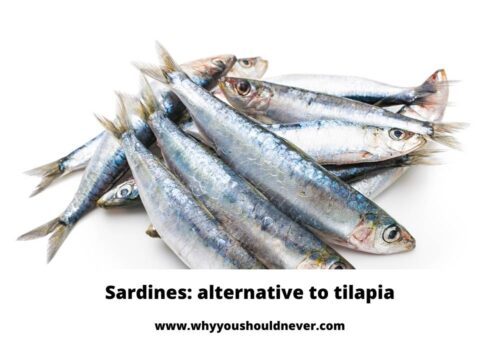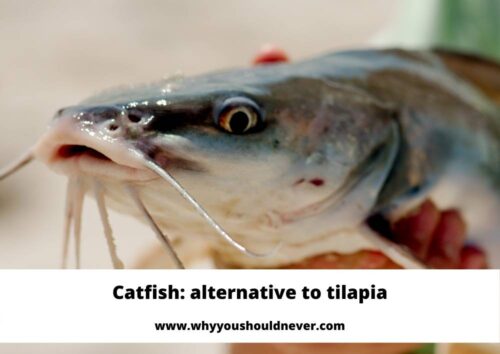![]()
Why You Should Never Eat Tilapia
When trying to maintain a healthy, balanced diet, it’s always been considered good practice to include fish, due to their source of proteins, vitamins, minerals, and essential fatty acid.
Not all fish is created equal, however. Tilapia, now one of the most popular farm-raised fish among consumers – thanks to its low price tag and mild, not-very-fishy taste – would seem like a good choice. Unfortunately, you put your health at risk with every bite you take.
The farming practices used in tilapia production have raised a number of concerns about how safe the fish is to eat.
NEED TO KNOW
What is Tilapia?
Tilapia refers to over 100 different species of freshwater fish belonging to the cichlid family. It grows quickly, subsists on a cheap, herbivore diet, and can survive in crowded tanks.
Originally, wild tilapia was an algae-eating fish native to Africa and the Middle East. In recent years, however, tilapia has been cultivated all across the world, and in order to keep up with demand, most of the fish sold today is mass-produced and raised in farms.
Is tilapia man-made?
Technically, no, tilapia is not man-made.
Producers often employ selective breeding techniques to cultivate a stronger fish; this involves somewhat genetically modifying it. Which has led many to believe that the tilapia available on the market is no longer real fish.
While this is an understandable conclusion to draw, it’s not as simple as that. Tilapia, no matter where it grows up, is still considered “real” – as real as salmon and sea bass that’s cultivated in the same fashion. The difference between farm-bred tilapia and wild tilapia is mostly in what they eat.
But this food choice can make all the difference in the world when it comes to your health.
In the remainder of this article, we’ll explore the reasons why you should stop eating tilapia, and what some of the alternatives are to this potentially hazardous fish.
4 reasons why tilapia is bad for you
1. Not enough omega-3
Fish are best known for their omega-3 fatty acid content, which is a polyunsaturated fat the body needs but cannot produce on its own.
While all fish contain omega-3, some have more than others. Unfortunately, tilapia provides 240 mg of omega-3 fatty acids per serving, ten times less than wild salmon (4,123 mg) offers.
As humans don’t get enough omega-3, choosing this fish over others that provide more would be unwise.
2. May cause inflammation or heart-attacks
Tilapia also contains more omega-6 fatty acids than omega-3. Although the body needs both in order to function, an over-consumption of omega-6 acids can lead to the following health issues:
- inflammation – your body will retain water
- high blood pressure
- heart-attack
- stroke
- blood clots
3. Tilapia may contain antibiotics and pesticides
Farmed tilapia are raised in crowded aquaculture tanks, which makes them more susceptible to diseases. In order to keep them alive, farmers continuously give them antibiotics. The fish are also treated with pesticides to fight and prevent sea lice.
Toxic chemicals used in raising farm-bred tilapia can weaken the immune system and cause other serious health problems.
For instance, trace levels of dioxin – an extremely toxic compound created during the manufacturing of herbicides – can be found in farm-raised tilapia. Dioxin has been linked to cancer.
4. Farm-rared tilapia is often fed feces/poop
Being bottom feeders, tilapia in tanks will consume anything, including substances that may be harmful and toxic to the end consumer.
Numerous reports have revealed that farm-bred tilapia from Asia are fed feces from chickens, pigs, and sheep.
Bacteria such as salmonella is found in animal waste, and eating fish that contains this type of bacteria would significantly increase your risk of catching something nasty.
Is tilapia from China safe to eat?
Sadly, most of the reports concerning the use of feces as tilapia feed come from China. Many farms there tend to take a blasé, do-anything-to-save-money approach to cultivating tilapia, which puts consumers’ health at risk.
What’s more, the United States Department of Agriculture (USDA) found that farm and food processors in China are located near contaminated regions.
Thus, it might be wise to steer clear of China-produced tilapia.
The trouble is, however, that China is the world’s largest producer of tilapia, and supplies most of the tilapia consumed in the US. It would be very difficult to know for sure where the tilapia you buy comes from.
Alternatives to tilapia
There are, quite literally, plenty more fish in the sea!
If you decide to avoid tilapia, you have many others to choose from that are affordable, taste just as good, and won’t be nearly as harmful. Some of these include:
Red snapper

They have a mild taste and are reasonably priced.
Sardines

They’re cheap, high in omega-3 (2,205 mg per serving) and contain almost all the nutrients the body needs.
Catfish

They’re low in calories, mild in taste, and are cheap to buy.
Conclusion
Due to the way it is cultivated and the high risk of ingesting harmful chemicals or bacteria, you might want to skip tilapia, particularly if it’s coming from Asia.
Wild tilapia is no better, as that is likely to contain a lot of mercury and plastic found in the sea.
The alternatives are plenty, and you can easily switch tilapia out for something that’s equally as versatile.
